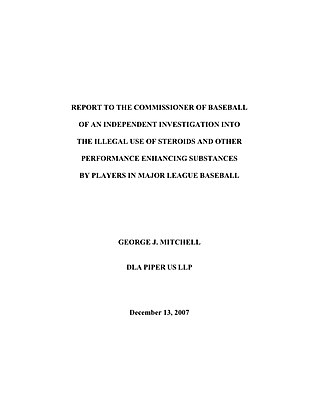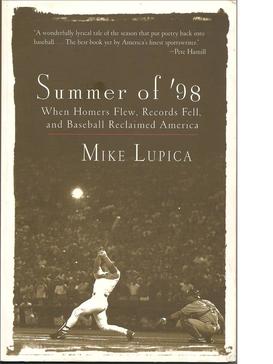
Mark David McGwire, nicknamed "Big Mac", is an American former professional baseball first baseman who played 16 seasons in Major League Baseball (MLB) from 1986 to 2001 for the Oakland Athletics and the St. Louis Cardinals. He won two World Series championships, one with Oakland as a player in 1989 and one with St. Louis as a coach in 2011. One of the most prolific home run hitters in baseball history, McGwire hit 583 home runs during his career, which ranked 5th-most in MLB history at the time of his retirement and currently ranks 11th. He holds the major-league career record for at bats per home run ratio (10.6), and is the former record holder for both home runs in a single season and home runs hit by a rookie. McGwire was one of several central figures in baseball's steroids scandal.

Eric Randolph Barnes is an American former shot putter who held the outdoor world record for the event from 1990 to 2021. He won silver at the 1988 Olympics and gold at the 1996 Olympics. Only three throwers have been within 40 centimetres (16 in) of his outdoor world record since it was set.

Androstenedione, or 4-androstenedione, also known as androst-4-ene-3,17-dione, is an endogenous weak androgen steroid hormone and intermediate in the biosynthesis of estrone and of testosterone from dehydroepiandrosterone (DHEA). It is closely related to androstenediol (androst-5-ene-3β,17β-diol).

Nandrolone, also known as 19-nortestosterone, is an endogenous androgen which exists in the male body at a ratio of 1:50 compared to testosterone. It is also an anabolic steroid (AAS) which is medically used in the form of esters such as nandrolone decanoate and nandrolone phenylpropionate. Nandrolone esters are used in the treatment of anemias, cachexia, osteoporosis, breast cancer, and for other indications. They are now used by oral administration or instead are given by injection into muscle or fat.
In competitive sports, doping is the use of banned athletic performance-enhancing drugs (PEDs) by athletic competitors, as a way of cheating. As stated in the World Anti-Doping Code by WADA, doping is defined as the occurrence of one or more of the anti-doping rule violations set forth in Article 2.1 through Article 2.11 of the Code. The term doping is widely used by organizations that regulate sporting competitions. The use of drugs to enhance performance is considered unethical, and is prohibited by most international sports organizations, including the International Olympic Committee. Furthermore, athletes taking explicit measures to evade detection exacerbate the ethical violation with overt deception and cheating.
Doping in baseball has been an ongoing issue for Major League Baseball (MLB). After repeated use by some of the most successful professional baseball players in MLB history, these banned substances found their way to the collegiate level. At the junior college level, due to lack of funding and NCAA drug testing, the abuse of PEDs is most common, but they are also an issue in Division I, II and III.
Performance-enhancing substances, also known as performance-enhancing drugs (PEDs), are substances that are used to improve any form of activity performance in humans. A well-known example of cheating in sports involves doping in sport, where banned physical performance-enhancing drugs are used by athletes and bodybuilders. Athletic performance-enhancing substances are sometimes referred to as ergogenic aids. Cognitive performance-enhancing drugs, commonly called nootropics, are sometimes used by students to improve academic performance. Performance-enhancing substances are also used by military personnel to enhance combat performance.
Patrick Arnold is an American organic chemist known for introducing androstenedione, 1-androstenediol, and methylhexanamine into the dietary supplement market, and for creating the designer steroid tetrahydrogestrinone, also known as THG and "the clear". THG, along with two other anabolic steroids that Arnold manufactured, not banned at the time of their creation, were hard-to-detect drugs at the heart of the BALCO professional sports doping scandal. BALCO distributed these worldwide to world-class athletes in a wide variety of sports ranging from track and field to professional baseball and football.
The BALCO scandal was a scandal involving the use of banned, performance-enhancing substances by professional athletes.

The Report to the Commissioner of Baseball of an Independent Investigation into the Illegal Use of Steroids and Other Performance Enhancing Substances by Players in Major League Baseball, informally known as the Mitchell Report, is the result of former Democratic United States Senator from Maine George J. Mitchell's 20-month investigation into the use of anabolic steroids and human growth hormone (HGH) in Major League Baseball (MLB). The 409-page report, released on December 13, 2007, covers the history of the use of illegal performance-enhancing substances by players and the effectiveness of the MLB Joint Drug Prevention and Treatment Program. The report also advances certain recommendations regarding the handling of past illegal drug use and future prevention practices. In addition, the report names 89 MLB players who are alleged to have used steroids or other performance-enhancing drugs.
Since their discovery, anabolic steroids (AAS) have been widely used as performance-enhancing drugs to improve performance in sports, to improve one's physical appearance, as self-medication to recover from injury, and as an anti-aging aid. Use of anabolic steroids for purposes other than treating medical conditions is controversial and, in some cases, illegal. Major sports organizations have moved to ban the use of anabolic steroids. There is a wide range of health concerns for users. Legislation in many countries restricts and criminalizes AAS possession and trade.

Dienedione, also known as estra-4,9-diene-3,17-dione, is a synthetic, orally active anabolic-androgenic steroid (AAS) of the 19-nortestosterone group that was never introduced for medical use. It is thought to be a prohormone of dienolone. The drug became a controlled substance in the US on January 4, 2010, and is classified as a Schedule III anabolic steroid under the United States Controlled Substances Act. Previous to this, it was sold as a bodybuilding supplement within the United States, and often mistakenly marketed as a prohormone for trenbolone, a veterinary steroid. Prior to its scheduling, it was part of a number of supplements that were seized during FDA enforcement of Bodybuilding.com for selling unapproved new drugs. The actual active metabolite, dienolone, is almost identical to trenbolone structurally, but lacks the C11 double bond.

1-Androstenedione, or 5α-androst-1-ene-3,17-dione, also known as 4,5α-dihydro-δ1-4-androstenedione, is a synthetic androgen and anabolic steroid. It is a 5α-reduced isomer of the endogenous steroid 4-androstenedione and acts as an androgen prohormone of 1-testosterone (4,5α-dihydro-δ1-testosterone), a derivative of dihydrotestosterone (DHT).
Doping, or the use of restricted performance-enhancing drugs in the United States occurs in different sports, most notably in the sports of baseball and football.

Trenbolone enanthate, known by the nickname Trenabol, is a synthetic and injected anabolic–androgenic steroid (AAS) and a derivative of nandrolone which was never marketed. It is the C17β enanthate ester and a long-acting prodrug of trenbolone. Trenbolone enanthate was never approved for medical or veterinary use but is used in scientific research and has been sold on the internet black market as a designer steroid for bodybuilders and athletes.

Summer of '98: When Homers Flew, Records Fell, and Baseball Reclaimed America is a 1999 book written by Mike Lupica, a sports columnist for the New York Daily News and an ESPN analyst. The book follows the 1998 baseball season that featured Mark McGwire and Sammy Sosa chasing Roger Maris's home run record. Lupica's book approaches the subject in a three generational context where his father, himself, and his son are all passionate baseball fans following the home run competition.

The Bash Brothers are a duo of former baseball players consisting of Jose Canseco and Mark McGwire. Both prolific home run hitters, the two were teammates in Major League Baseball (MLB) for seven seasons with the Oakland Athletics, helping the team win a World Series title in 1989.

19-Nor-5-androstenediol, also known as estr-5-ene-3β,17β-diol, is a synthetic, orally active anabolic-androgenic steroid (AAS) and a derivative of 19-nortestosterone (nandrolone) that was never introduced for medical use. It is an androgen prohormone of nandrolone and of other 19-norandrostanes.

19-Nor-5-androstenedione, also known as estr-5-ene-3,17-dione, is a synthetic, orally active anabolic-androgenic steroid (AAS) and a derivative of 19-nortestosterone (nandrolone) that was never introduced for medical use. It is an androgen prohormone of nandrolone and of other 19-norandrostanes.











